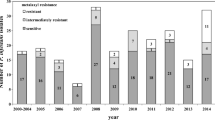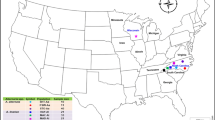Abstract
A total of 80 single–lesion isolates of Phytophthora infestans were collected from tomatoes and potatoes in several locations in Chiang Mai and Tak provinces in 2000–2002. These isolates were analyzed for mating type, metalaxyl sensitivity, mitochondrial DNA (mtDNA) haplotype RFLP pattern as determined by probe RG57, and for microsatellite markers. All isolates were A1 mating type. Isolates from tomato were usually sensitive to metalaxyl, but isolates from potato were usually resistant to metalaxyl. With one exception, all tomato isolates were related to the US-1 clonal lineage. With two exceptions, all potato isolates were related to two European lineages. In these two provinces, the populations of P. infestans on tomatoes are clearly different from those on potatoes.




Similar content being viewed by others
References
Abu-El Samen, F. M., Secor, G. A., & Gudmestad, N. C. (2003). Variability in virulence among asexual progenies of Phytophthora infestans. Phytopathology, 93, 293–304.
Ashley, M. V., & Dow, B. D. (1994). The use of microsatellite analysis in population biology: background, methods, and potential applications. In B. Sherwater, B. Streit, G. P. Wagner, & R. DeSalle (Eds.), Molecular ecology and evolution: approaches and applications (pp. 185–201). Basel: Birkhauser.
Chamsawarng, C., Leeprasert, P., & Chantana - o tan, S. (1985). Population assesments of soil borne plant pathogens, Sclerotium rolfsii, Pythium spp., Phytophthora spp. in soil and their correlation to disease incidence on intercropping system. In Cropping Programmes KU– ACNARP. Fact. of Agri., Kasetsart Univ., Bangkok, Thailand. 80 P.
Cooke, D. E. L., & Lees, A. K. (2004). Markers, old and new, for examining Phytophthora infestans diversity. Plant Pathology, 53, 692–704.
Cooke, D. E. L., Cano, L. M., Raffaele, S., Bain, R. A., Cooke, L. R., Etherington, G. J., et al. (2012). Genome analyses of an aggressive and invasive lineage of the irish potato famine pathogen. PLoS Pathogens, 8, e1002940.
Cox, A.E. & Large, E.C. (1960). Potato blight epidemics throughout the world. U.S. Dep. Agric. Handb. 174–230 pp.
Davidse, L. C., Looijen, D., Turkensteen, L. J., & van der Wal, D. (1981). Occurrence of metalaxyl-resistant strains of Phytophthora infestans in Dutch potato fields. Netherlands Journal of Plant Pathology, 87, 65–68.
Day, J. P., Wattier, R. A. M., Shaw, D. S., & Shattock, R. C. (2004). Phenotypic and genotypic diversity in Phytophthora infestans on potato in Great Britain, 1995–98. Plant Pathology, 53, 303–315.
Dowley, L. J., & O’Sullivan, E. (1981). Metalaxyl-resistant strains of sensitive and metalaxyl-resistant isolates of Phytophthora infestans in the absence of metalaxyl. Plant Pathology, 37, 558–564.
Drenth, A., Goodwin, S. B., Fry, W. E., & Davidse, L. C. (1993). Genotypicdiversity of Phytophthora infestans in the Netherlands revealed by DNA polymorphisms. Phytopathology, 83, 1087–1092.
Drenth, A., Tas, I. C. Q., & Govers, F. (1994). DNA fingerprinting uncovers a new sexually reproducing population of Phytophthora infestans in the Netherlands. European Journal of Plant Pathology, 100, 97–107.
Forbes, G. A., Goodwin, S. B., Drenth, A., Oyarzun, P., Ordoñez, M. E., & Fry, W. E. (1998). A global marker database for Phytophthora infestans. Plant Disease, 82, 811–818.
Fraser, D. E., Shoemaker, P. B., & Ristaino, J. B. (1999). Characterization of isolates of Phytophthora infestans from tomato and potato in North Carolina from 1993 to 1995. Plant Disease, 83, 633–638.
Fry, W. E., Goodwin, S. B., Matuszak, J. M., Spielman, L. J., Milgroom, M. G., & Drenth, A. (1992). Population genetics and intercontinental migrations of Phytophthora infestans. Annual Review of Phytopathology, 30, 107–129.
Gallegly, M. E., & Galindo, J. (1958). Mating type and oospores of Phytophthora infestans in nature in Mexico. Phytopathology, 48, 274–277.
Griffith, G. W., & Shaw, D. S. (1998). Polymorphisms in Phytophthora infestans: Four mitochondrial haplotypes are detected after PCR amplification of DNA from pure cultures of from host lesions. Applied Environmental Microbiology, 64, 4007–4014.
Goodwin, S. B., Drenth, A., & Fry, W. E. (1992). Cloning and genetic analyses of two highly polymorphic, moderately repetitive nuclear DNAs from Phytophthora infestans. Current Genetics, 22, 107–115.
Goodwin, S. B., Cohen, B. A., Deahl, K. L., & Fry, W. E. (1994). Migration from northern Mexico as the probable cause of recent genetic changes in populations of Phytophthora infestans in the United States and Canada. Phytopathology, 84, 553–558.
Goodwin, S. B., Sujkowski, L. S., & Fry, W. E. (1995). Rapid evolution of pathogenicity within clonal lineages of the potato late blight disease fungus. Phytopathology, 85, 669–676.
Gotoh, K., Akino, S., Maeda, A., Kondo, N., Naito, S., Kato, M., & Ogoshi, A. (2005). Characterization of some Asian isolates of Phytophthora infestans. Plant Pathology, 54, 733–739.
Hohl, H. R., & Iselin, K. (1984). Strains of Phytophthora infestanswith the A2 mating type behaviour. Transactions of the British Mycological Society, 83, 529–530.
Jarne, P., & Lagoda, P. J. L. (1996). Microsatellites, from molecules to populations and back. Trends in Ecology and Evolution, 10, 424–429.
Jaccard, P. (1908). Nouvelles recherches sur la distribution florale. Bulletin Society Vaudoise Science Nature, 44, 223–270.
Jaimasit, P., & Prakob, W. (2010). Characterization of Phytophthora infestans population in potato crops from Chiang Mai and Tak Provinces. Journal of Agricultural Technology, 6(1), 117–125.
Knapova, G., & Gisi, U. (2002). Phenotypic and genotypic structure of Phytophthora infestans populations on potato and tomato in France and Switzerland. Plant Pathology, 51, 641–653.
Lees, A. K., Wattier, R., Shaw, D. S., Sullivan, L., Williams, N. A., & Cooke, D. E. L. (2006). Novel microsatellite markers for the analysis of Phytophthora infestans populations. Plant Pathology, 55, 311–319.
Nishimura, R., Sato, K., & Lee, W. H. (1999). Distribution of Phytophthora infestans populations in seven Asian countries. Annals of the Phytopathological Society of Japan, 65, 163–170.
Pittis, J. E., & Shattock, R. C. (1994). Viability, germination and infection potential of oospores of Phytophthora infestans. Plant Pathology, 43, 387–396.
Queller, D. C., Strassman, J. E., & Hughes, C. R. (1993). Microsatellites and kinship. Trends in Ecology and Evolution, 8, 285.
Reis, A., Smart, C. D., Fry, W. E., Maffia, L. A., & Mizubuti, E. S. G. (2003). Characterization of Phytophthora infestans isolates from Southern and Southeastern Brazil from 1998 to 2000. Plant Disease, 87, 896–900.
Rohlf, F. J. (2005). NTSYSpc (Numerical Taxonomy and Mutivarate Analysis System). Version 2.2. New York: Exeter Software. Applied Biostatistics Inc.
Schlötterer, C., & Pemberton, J. (1994). The use of microsatellites forgenetic analysis of natural populations. In B. Schierwater, B. Streit, G. P. Wagner, & R. DeSalle (Eds.), Molecular ecology and evolution: approaches and applications (pp. 203–13). Basel: Birkhäuser-Verlag.
Sneath, P. H. A., & Sokal, R. R. (1973). Numerical taxonomy. San Francisco: W. H. Freeman and Company.
Sopee, J. (2012). Population biology of Phytophthora infestans in Northern Thailand. Ph. D. thesis Kasetsart University.
Spielman, L. J., Drenth, A., Davidse, L. C., Sujkowski, L. J., Gu, W., TooleyP, W., & Fry, W. E. (1991). A second world-wide migrationand population displacement of Phytophthora infestans. Plant Pathology, 40, 422–430.
Tooley, P. W., Fry, W. E., & Villareal-Gonzalez, M. J. (1985). Isozyme characterization of sexual and asexual Phytophthora infestans populations. The Journal of Heredity, 76, 431–35.
Yap, I. V., & Nelson, R. J. (1996). WinBoot: a program for performing bootstrap analysis of binary data to determine the confidence limits of UPGMA-based dendrograms (IRRIDisc. Ser. No. 14). Manila: Int. Rice Res. Inst.
Acknowledgments
The authors gratefully acknowledge the Center of Excellence on Agricultural Biotechnology, Science and Technology Postgraduate Education and Research Development Office, Office of Higher Education Commission, Ministry of Education (AG-BIO/PERDO-CHE), for Ph. D. grant. We are also grateful for the National Center for Genetic Engineering and Biotechnology for the research and Ph. D. grants. The Tropical Vegetable Research Center (TVRC), Kasetsart University, and Tomato Genetic Center, UC Davis, for tomato seeds and we thank Dr. W. Stevenson of the University of Wisconsin-Madison for the P. infestans standard isolates, Dr. W. E. Fry of Cornell University for providing the RG57 probe and the P. infestans standard isolates, Associate Professor Dr. Wichai Kositratana and Dr. David Hole for their valuable comments. We thank Mr. Michael Cooper for English proof reading of the manuscript.
Author information
Authors and Affiliations
Corresponding author
Rights and permissions
About this article
Cite this article
Petchaboon, K., Srisawad, N., Pongam, P. et al. Phenotypic and genotypic structure of Phytophthora infestans populations on tomato and potato in the North of Thailand in 2000–2002. Eur J Plant Pathol 140, 441–454 (2014). https://doi.org/10.1007/s10658-014-0479-5
Accepted:
Published:
Issue Date:
DOI: https://doi.org/10.1007/s10658-014-0479-5




